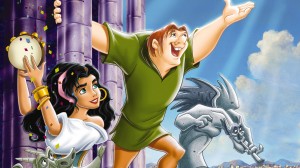At Notre Dame, our English-speaking guide was named Fredérique. She was one of the two English guides. The choice was simple: did you want to go up the bleachers with Fredérique, or did you want to stay on solid ground with the other woman? We chose Fredérique.
At the top of the bleachers, she talked for a long time about Notre Dame’s history. Notre Dame, which means ‘our lady,’ referring to the Virgin Mary, used to be painted in bright colors. During the French Revolution, the kings from the Old Testament, who were portrayed on the front of the building, had their stone heads cut off because the revolutionaries didn’t like kings. Later, twenty brightly painted heads were found under a bank.
On solid ground in front of the giant Gothic doors, Fredérique discussed all the symbolism, such as the square shape of the front of the building representing Creation and the circular window representing eternity, since it has no end or corner. Statues of the prophets, gargoyles, apostles, angels, devils, and saints, as well as Jesus, decorate the front of the cathedral. One of the most interesting was Saint Denis, the first patron saint of Paris. He was an evangelist in 200 A.D., and he was popular, which the Romans in Paris didn’t like. So they killed him, and legend has it that he walked over to his head, picked it up, cleaned it, and then walked over to the spot of a present-day church, where he died “for real.”
Inside the cathedral, Fredérique talked about the architecture while we admired the stained-glass windows. Once we were sufficiently rested, she took us over to a pillar and showed us the workers’ signatures on the stone. In this way, the boss could tell how many pieces of stone a man had shaped and/or affixed in a day.
There were several Joan of Arc statues inside, as well as the Notre Dame. Notre Dame Cathedral was the place where it was decided that Joan of Arc’s reputation should be rehabilitated. It is also the location of the crown of thorns that Jesus wore on the cross. Napoleon gave it back to the church after he was crowned king in the cathedral. It had been M.I.A. because Notre Dame had been used as a temple of the goddess of reason during the French Revolution. Later on, the general public had seemed to have given up on the cathedral until Victor Hugo wrote Hunchback of Notre Dame, which was hugely popular and later made into a Disney movie, which I’ve seen.
Ciao!

